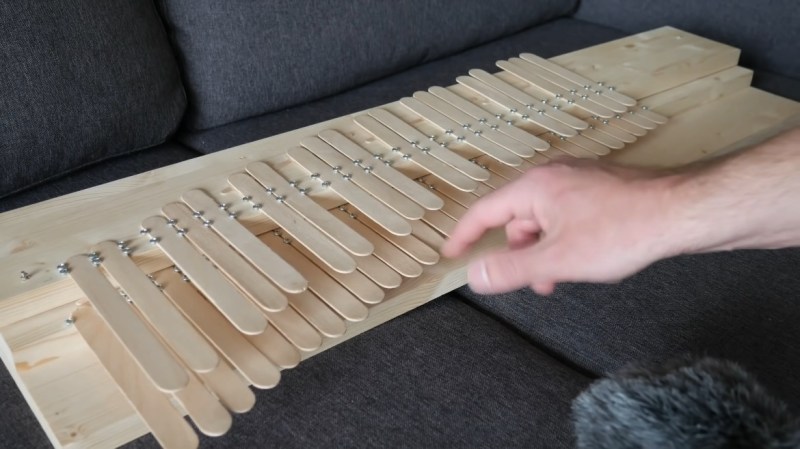Technically, this is a kalimbaphone, and not a piano or even a chordophone since there are no strings. But this handcrafted instrument doesn’t just sound sweet, it’s also mellow, and it’s much nicer than you’re probably imagining. Go check out the short build video, which starts with a demo.
[Mash] started by drilling a bunch of holes into a rectangular piece of wood, and then twisted in wood screws far enough to stay in. Then [Mash] laid Popsicle sticks between each set of screws and tuned them one at a time, starting with middle C. The Popsicle stick version didn’t sound so great, so [Mash] upgraded to tongue depressors and moved the black keys up to their own layer. Unfortunately, the owner has turned off embeds for the video, so you’ll have to watch it on YouTube.
We’d love to see [Mash] figure out a way to make the sticks resonate. In the meantime, check out this 3D-printed grand piano mechanism. And if this build has you in the mood to listen to Popcorn on a homemade instrument, well, we’ve got you covered there.
Thanks to [Keith] for the tip!
















“The Popsicle stick version didn’t sound so great, so [Mash] upgraded to tongue depressors…”
So contrary to the article title, the popsickle-stick piano *didn’t* sound sweet.
The popsicles _were_ sweet, their handles, not so much.
B^)
“We’d love to see [Mash] figure out a way to make the sticks resonate.”
I’m guessing that would involve some form of chamber (e.g. cigar box).
Ah the new Hackaday meme. Why did you use a Raspberry Pi, could have done that with a sliver of wood.
Indeed, using Raspberry Pi Zeroes would:
1) Probably not vibrate as well
2) Be more uncomfortable fingers when playing
3) Probably not be available in the necessary quantities
Drilling those holes though. On a nice table.
That’s pretty cool. Mount a MEMS microphone, a small amp, speaker, and a couple batteries to power it on the board and you’ve got a neat little geek toy.
There is too much mass in the boards. Make them slim but able to hold the screws, then attach to stiff cardboard or even foam board like those speakers on YouTube that have a mass driver and a lightweight panel instead of a paper cone. The worst thing to do is to place what you have on a dampening sofa cushion. Try placing it on a big cardboard box for starts.
Sound travels best in a low mass high rigidity medium. The standard is the close gain spruce soundboard of a good piano. Now they’re free for the moving sometimes. Speed of sound in air is Mach 1, speed of sound in spruce Mach 10! Faster than the latest missiles. The vibrations get everywhere fast to move the air efficiently.
Reminded me of an old song… Popcorn by Hot Butter….
https://youtu.be/YfdLh0MHqKw
Warning… This video can not be unseen… 😄
I recently made something a bit similar, but with a thin ferromagnetic metal sheet (from anti-theft sticker), magnetic pickup and transistor amplifier: https://www.minds.com/newsfeed/1302009724685783046 On this video there’s an early version with lots of noise, now I managed to reduce it – mainly by adding some capacitors between transistors bases and ground.
Why not build synthesizer instead?
https://www.youtube.com/watch?v=Ns2zEPwnSt4
More like a big kalimba with wooden tines. I dig it!